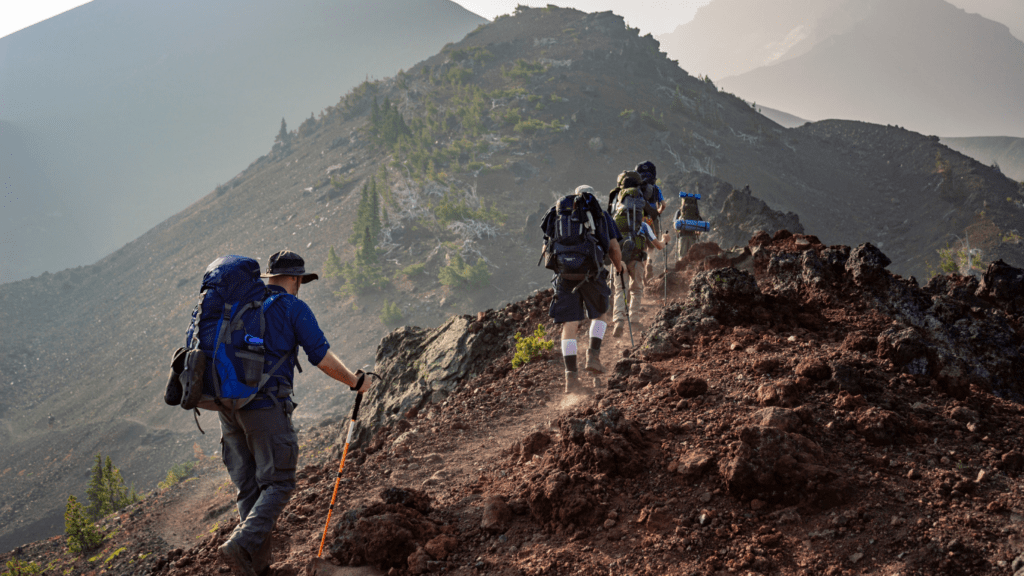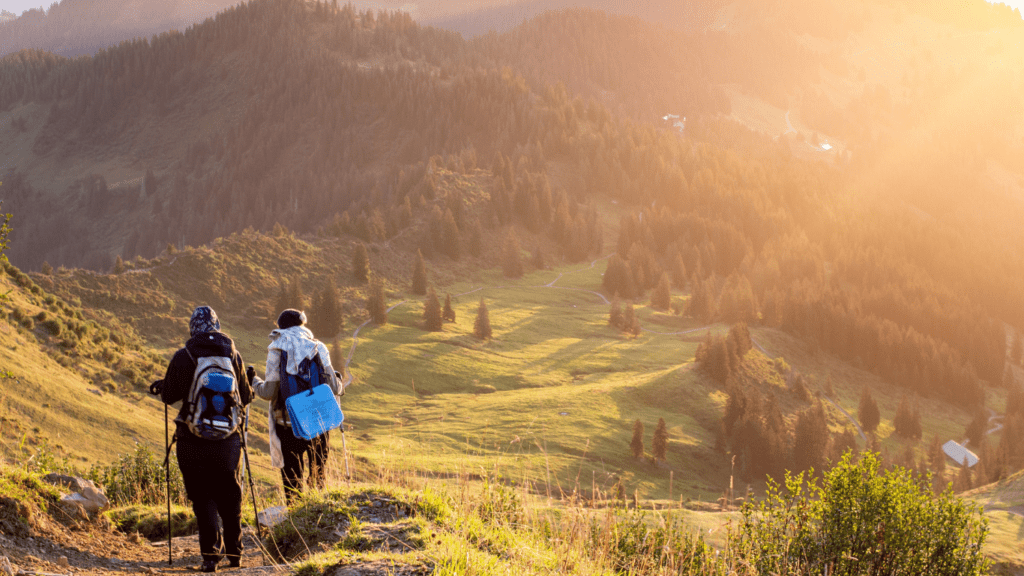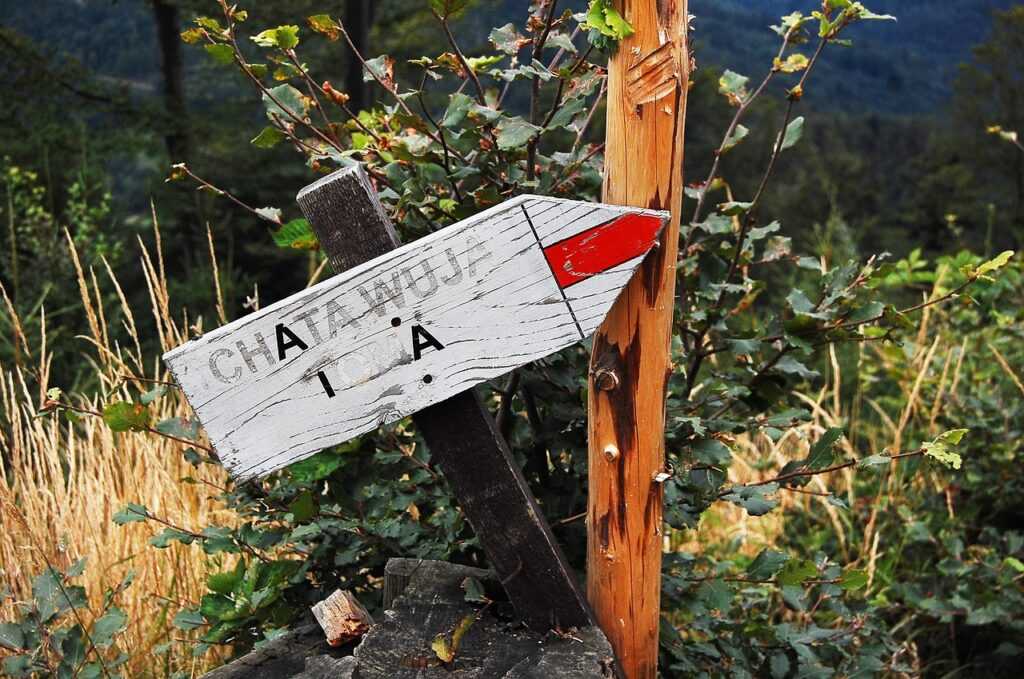Understanding Different Types of Terrain
Hikers face various terrain types, each presenting unique challenges requiring specific skills. Basic terrain types include rocky paths, muddy trails, water crossings, and steep inclines.
Rocky Paths
Rocky paths demand careful foot placement to avoid ankle injuries. Large rocks and uneven surfaces can cause instability. Using trekking poles helps maintain balance. Select shoes with sturdy soles for better grip. Small stones can be tricky, so watch every step. Examples: Appalachian Trail, Rocky Mountains.
Muddy Trails
Muddy trails become slippery after rain. High waterproof boots keep feet dry. Stick to the center of the trail to avoid deeper mud on the sides. Shortening your stride prevents falls. Examples: Pacific Northwest, Southeast US.
Water Crossings
Streams and rivers often interrupt paths. Look for shallow, slow-moving sections to cross. Use trekking poles to test depth. Remove socks to keep them dry before crossing. Examples: Sierra Nevada, Great Smoky Mountains.
Steep Inclines
Steep inclines tire legs quickly. Use a zig-zag path, called switchbacks, to reduce strain. Adjust the backpack for better weight distribution. Short breaks help maintain energy. Examples: White Mountains, Sierras.
Hiking experience improves by understanding and preparing for different terrain types. The right equipment and techniques make difficult trails manageable and enjoyable.
Essential Gear for Difficult Terrain
Navigating difficult terrain requires the right gear. Having proper equipment boosts safety and enhances the hiking experience.
Footwear
Quality footwear is essential on challenging trails. Sturdy, ankle-high hiking boots prevent injuries by providing support and protection. Waterproof materials keep feet dry in muddy or wet conditions. Investing in boots with a durable sole and good tread enhances grip on rocky or slippery paths. I prefer boots with a moisture-wicking lining to keep my feet comfortable on long hikes.
Trekking Poles
Trekking poles offer stability and support on uneven terrain. Adjustable poles with ergonomic grips reduce strain on knees and improve balance. They’re particularly useful when crossing streams or navigating steep inclines. For instance, I always extend my poles to maximize support when descending steep slopes. Using poles with shock absorbers can also minimize impact on joints.
Navigation Tools
Reliable navigation tools are crucial in unfamiliar terrain. A topographic map paired with a compass ensures accurate route planning. GPS devices provide real-time tracking and can store multiple waypoints. I carry a weatherproof map case to protect vital navigation materials. Having a backup power source for electronic devices is also wise.
Techniques for Navigating Rocky Terrain

Rocky terrain presents unique challenges that require specific techniques. Understanding how to move across rocks can significantly improve safety and efficiency.
Proper Foot Placement
Using deliberate foot placement on rocky terrain is essential. Place your foot on flat surfaces or large, stable rocks to maximize contact and reduce the risk of slipping. Step on the ball of your foot first to maintain balance, then lower your heel. Scan ahead to identify potential footholds instead of looking down constantly.
Balancing Strategies
- Maintaining balance on rocky terrain demands an active approach.
- Use trekking poles to enhance stability, especially when facing uneven ground or large rocks.
- Engage your core muscles to keep your center of gravity low.
- Distribute weight evenly by keeping your knees slightly bent and your arms extended for better equilibrium.
- Practice shifting weight from one foot to the other to adapt to changing surfaces.
Tackling Slippery and Wet Surfaces
Navigating slippery and wet surfaces poses unique challenges on the trail. Preparation and correct techniques can keep you steady and safe.
Choosing Safe Footpaths
Selecting safe footpaths is essential when dealing with wet conditions. Choose paths with minimal mud and standing water. Rockier sections often provide more traction. Look for grassy patches or areas with coarse gravel, as these may offer better grip. Avoid paths with moss or algae, as they tend to be extremely slippery. Always test the stability of each step before shifting your weight fully.
Utilizing Poles for Stability
Using trekking poles greatly enhances stability on slippery terrain. Adjust the poles to a slightly lower height to increase stability. Place the poles firmly on the ground before stepping. When crossing wet rocks or roots, use the poles to test surfaces for slickness. Distribute your weight between the poles and your legs. Keep your body centered and use the poles to maintain balance.
Managing Steep Inclines and Declines
Navigating steep inclines and declines on the trail requires focused techniques and specialized skills.
Ascending Techniques
Climbing steep inclines on a trail is demanding but manageable with the right approach. I keep my center of gravity low and use a zigzag pattern, often referred to as switchbacks, to reduce the gradient’s intensity. My steps are short and deliberate to maintain balance. I also use trekking poles to assist in pulling myself upward and distribute some of my body weight to my upper body, which helps conserve energy. Wearing quality hiking boots with good ankle support is crucial to prevent twisted ankles and provide traction.
Descending Techniques
Descending steep slopes can be just as challenging as climbing. When going downhill, I lean slightly back to counterbalance the downward pull and use a slow, controlled pace to prevent slipping or falling. My knees stay slightly bent to absorb impact, and I plant my feet firmly with each step. Trekking poles are useful for stability, as they provide additional points of contact with the ground. I ensure my footwear has good tread to grip the surface effectively. Additionally, I avoid running or taking large steps, which can increase the risk of losing control and falling.
Safety Tips and Best Practices
For staying safe on the trail, it’s crucial to follow proven safety tips and best practices. Ensuring proper preparation, using the right gear, and applying effective techniques can make all the difference.
Preparation and Planning
Before setting out, I always research the trail thoroughly, checking weather conditions, trail maps, and potential hazards. I inform someone of my plans and expected return time to ensure help can reach me if needed. Carrying a fully charged phone with emergency contact numbers programmed is essential for immediate communication.
Gear Selection
Using the right gear is vital. I choose sturdy, ankle-high hiking boots for foot protection and stability. Trekking poles provide extra support, especially on uneven or slippery terrain. Packing a first aid kit, water, and high-energy snacks ensures I stay prepared for emergencies.
Hydration and Nutrition
Staying hydrated is crucial. I drink water regularly, even if I’m not thirsty, to maintain energy levels and avoid dehydration. Carrying a water purification method, such as tablets or a filter, allows me to utilize natural water sources safely. High-energy snacks like:
- nuts
- dried fruit
- energy bars
keep my stamina up during long hikes.
Navigation
Reliable navigation tools are non-negotiable. I bring a topographic map, compass, and GPS device to ensure I stay on course. Even if I’m using a digital tool, carrying a physical map as a backup is prudent. Learning basic navigation skills can help me avoid getting lost in unfamiliar areas.
Pace and Rest
Maintaining a steady pace conserves energy. I take regular breaks to rest, rehydrate, and eat, preventing exhaustion and reducing the risk of injury. Short, frequent rest stops are more effective than long breaks and help keep momentum up.
Environmental Awareness
Being aware of my surroundings helps me avoid potential hazards. I watch for unstable ground, wildlife, and weather changes. If conditions deteriorate, knowing when to turn back or seek shelter is crucial.
Proper Foot Techniques
Using proper foot techniques improves stability and reduces injury risks. On rocky terrain, I place my feet on flat surfaces or stable rocks. For muddy paths, waterproof boots and careful foot placement prevent slips. On steep inclines, I use a zigzag pattern for climbing and lean slightly back when descending to control speed and balance.
Trekking Poles
Trekking poles enhance stability. Adjusting pole height to match the terrain, testing surfaces for slickness, and distributing weight evenly reduces the risk of falls. Poles also conserve energy on long hikes by reducing strain on legs and knees.
Staying Calm
Staying calm is key in unexpected situations. If I encounter an obstacle or get lost, I stay composed and assess my options. Panicking can lead to poor decision-making. I prioritize safety and use my knowledge and tools to navigate the situation.
Implementing these tips and best practices ensures a safe and enjoyable hiking experience. Proper preparation, effective use of gear, and staying aware of my environment build confidence and enhance my trail navigation skills.




